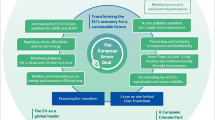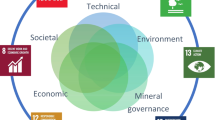Abstract
Transboundary pollution is an international problem. There are currently no adequate mechanisms under international law to balance the relationship between state sovereignty and state responsibility for transboundary pollution harm. The doctrine of liability fixation is at the core of state responsibility and plays an important role in transboundary environmental harm. What type of responsility, fault liability or strict liability should be adopted in state responsibility for transboundary pollution harm? Scholars have different viewpoints on this key issue, and states may have fundamentally different positions and differ widely in terms of both policy and substantive issues. There is uncertainty and variability in the drafting of international conventions on transboundary pollution harm. This article focuses on the normal international legal rules regarding the principle of imputation, and it analyses the advantages and disadvantages of adopting the principles of strict liability and fault liability, their value and the relationship between state responsibility and civil subject liability. This article aims to explain why it is necessary to change the direction of the doctrine of liability fixation of state responsibility in the convention on transboundary pollution harm, and it considers a new direction to adapt to the complex interests and demands of various countries. From the perspective of furthering the prevention of pollution and determining compensation for harm and constructing liability regimes for transboundary pollution, this article proposes the doctrine of the liability fixation of state responsibility and analyses the relevant trends and possible available options.
Similar content being viewed by others
Abbreviations
- ILC:
-
International Law Commission
References
Banda, M. L. (2019). Regime congruence: Rethinking the scope of state responsibility for transboundary environmental harm. Minnesota Law Review,103(4), 1879.
Birnie, P. W., & Boyle, A. E. (2002). International law and the environment. Oxford: Oxford University Press.
Boyle, A. E. (1990). State responsibility and international liability for injurious consequences of acts not prohibited by international law: A necessary distinction? International and Comparative Law Quarterly,39(1), 1–26.
Brownlie, I. (1983). System of the law of nations state responsibility (Part I). Oxford: Clarendon Press.
Callahan, C. M. (2018). Transboundary pollution and CERCLA liability: International manufacturers’ ability to exploit aerial depositions. Idaho Law Review,54(1), 145.
Cassese, A. (2009). International law (C. Cai, Trans.). Beijing: Law Press (in Chinese).
Cole, D. H. (2015). The problem of shared irresponsibility in international climate law. Articles by Maurer Faculty. 2408. Retrieved November 19, 2019, from http://www.repository.law.indiana.edu/facpub/2408.
Doeker, G., & Gehring, T. (1990). Private of international liability for transnational environmental damage-the precedent of conventional liability Regimes. Journal of Environmental Law,2(1), 1.
Dumbauld, E. (1987). Netherlands Yearbook of International Law: Book reviews and notes. American Journal of International Law,81(2), 549–551.
Dupuy, P. M. (1991). Soft law and the international law of the environment. Michigan Journal of International Law,12(2), 420.
Fuchs, M. (2004). Law of torts (X. K. Qi, Trans.). Beijing: Law Press (in Chinese).
Gaines, S. E. (1989). International principles for transnational environmental liability: Can developments in municipal law help break the impasse? Harvard International Law Journal,30(2), 311.
Guruswamy, L. (2010). State responsibility in promoting environmental corporate accountability. Fordham Environmental Law Review,21, 209.
Hall, N. D. (2007). Transboundary pollution: Harmonizing international and domestic law. University of Michigan Journal of Law Reform,40(4), 681.
Handl, G. (1980). The environment: International rights and responsibilities. American Society of International Law Proceedings,74, 223–247.
Herdegen, M. (2007). International economic law (Q. Y. Jiang, Trans.). Shanghai: Shanghai People’s Publishing House (in Chinese).
Horbach, N. L. J. T. (1991). The confusion about state responsibility and international liability. Leiden Journal of International Law,4(1), 47–74.
Jiang, Z. P., & Li, T. Y. (2017). Transboundary pollution and local governance dilemma: A case study of the Indonesian government to deal with the haze. Southeast Asian Affairs,170(2), 7.
Jin, Y. (2016). Current situation and future challenge of Fukushima nuclear accident in Japan. Contemporary World, 10, 53.
Magraw, D. B. (1986). Transboundary harm: The International Law Commission’s study of international liability. American Journal of International Law,80(2), 305–330.
Mazzeschi, R. P. (1992). The due diligence rule and the nature of the international responsibility of states. German Yearbook of International Law,35, 9.
Merrill, T. W. (1997). Golden rules for transboundary pollution. Duke Law Journal,46(5), 931.
Mohan, M. (2017). A Domestic solution for transboundary harm: Singapore’s haze pollution law. Business and Human Rights Journal,2(2), 325–333.
O’Keefe, C. (1990). Transboundary pollution and the strict liability issue: The work of the International Law Commission on the topic of international liability for injuries consequences arising out of acts not prohibited by international law. Denver Journal of International Law and Policy,18(2), 145.
Phil, R. (1984). Risk liability in international law. Report Collection of German International Law Association, 24(1), 35.
Rao, P. S. (2004). International liability for transboundary harm. Environmental Policy and Law,34(6), 224.
Rosas, A. (1994). State responsibility and liability under civil liability regimes. In O. Bring & S. Mahmoudi (Eds.), Current international law issues: Nordic perspectives. Dordrecht: Martinus Nijoff.
Sands, P. (2003). Principles of international environmental law. Cambridge: Cambridge University Press.
Sersic, M. (2008). Responsibility and liability for the pollution of the marine environment: Responsibility of states and civil liability. In Zbornik Pravnog: Fakulteta Zagrebu, 58(1).
Sinden, A. (2010). Allocating the costs of the climate crisis: Efficiency versus justice. Washington Law Review,85(2), 293.
Springer, A. L. (1983). The international law of pollution: Protecting the global environment in a world of sovereign states. Westport: Springer.
Stone, C. D. (1993). The gnat is older than man: Global environment and human agenda. Princeton: Princeton U. Press.
Suzuki, Y., & Souji, Y. (Eds.). (1988). Basis of international law (Q. Zhu, & D. Liu, Trans.). Beijing: China Renmin University Press (in Chinese).
Townley, S. (2018). The rise and risk in international law. Chicago Journal of International Law, 18(2), 619.
Usuki, T. (1989). International liability for transboundary harm. The Hokkaido Law Review, 40(1), 1–70.
Vordermayer, M. (2018). The extraterritorial application of multilateral environmental agreements. Harvard International Law Journal,59(1), 59.
Wang, T. Y. (1995). International law. Beijing: Law Press. (in Chinese).
Wetterstein, P. (1997). A proprietary or possessory interest: A condition sine qua non for claiming damage for environmental impairment. In P. Wetterstein (Ed.), Harm to the environment: The right to compensation and assessment of damage. Oxford: Oxford Clarendon Press.
Xie, Y. G., Wang, J. L., & Pan, J. (2013). Discussion on Sino-Russia cross-border water pollution and cooperation mechanisms for regional disaster reduction. Northeast Asia Forum, 108(4) (in Chinese).
Zhao, J. W. (2000). New international law theory. Beijing: Law Press. (in Chinese).
Zhou, X. L. (1988). International liability for extraterritorial harm arising out of lawful activities. China Legal Science, 5, 121. (in Chinese).
Zhou, Z. H. (2004). International law. Beijing: China University of Political Science and Law Press. (in Chinese).
Policy documents
ILC. (1978). Report of the International Law Commission on the work of its Thirtieth session, 8 May–28 July 1978, Official Records of the General Assembly, Thirty-third session. Document: A/33/10.
ILC. (1983). Report of the International Law Commission on the work of its Thirty-fifth session, 3 May–22 July 1983, Official Records of the General Assembly, Thirty-eighth session. Document: A/38/10.
ILC. (1991). Report of the International Law Commission on the work of its forty-third session, 29 April–19 July 1991, Official Records of the General Assembly, Forty-sixth session. Document: A/46/10.
ILC. (1992). Report of the International Law Commission on the work of its forty-fourth session, 4 May–24 July 1992, Official Records of the General Assembly, Forty-seventh session. Document: A/47/10.
ILC. (1994). Report of the International Law Commission on the work of its forty-sixth session, 2 May–22 July 1994, Official Records of the General Assembly, Forty-ninth session. Document: A/49/10.
ILC. (1996). Report of the International Law Commission on the work of its forty-eighth session, 6 May–26 July 1996, Official Records of the General Assembly, Fifty-first session. Document: A/51/10.
ILC. (1997). Report of the International Law Commission on the work of its forty-ninth session, 12 May–18 July 1997, Official Records of the General Assembly, Fifty-second session. Document: A/52/10.
ILC. (1998). Report of the International Law Commission on the work of its fiftieth session, 20 April–12 June and 27 July–14 August 1998, Official Records of the General Assembly, Fifty-third session. Document: A/53/10.
ILC. (2002). Report of the International Law Commission on the work of its fifty-fourth session, 27 and 30 May, on 23, 24 and 29 July and on 1 August 2002. Document: A/57/10.
ILC. (2003). Report of the Commission to the General Assembly on the work of its fifty-fifth session, On 23, 27, 28, 30 May and 3 to 6 June 2003. Document: A/58/10.
ILC. (2006). Report of the Commission to the General Assembly on the work of its fifty-eighth session, On 9, 10, 11 and 12 May 2006. Document: A/61/10.
United Nations. (1979). Convention on Long-Range Transboundary Air Pollution. International Legal Materials, vol. 18, no. 6, November 1979, Done at Geneva.
Acknowledgements
The authors of this paper would like to thank the editors and three anonymous reviewers for valuable comments on this manuscript.
Author information
Authors and Affiliations
Corresponding author
Ethics declarations
Conflict of interest
The author declares that he has no conflict of interest.
Additional information
Publisher's Note
Springer Nature remains neutral with regard to jurisdictional claims in published maps and institutional affiliations.
Rights and permissions
About this article
Cite this article
Hu, X. The doctrine of liability fixation of state responsibility in the convention on transboundary pollution damage. Int Environ Agreements 20, 179–195 (2020). https://doi.org/10.1007/s10784-019-09466-3
Accepted:
Published:
Issue Date:
DOI: https://doi.org/10.1007/s10784-019-09466-3




